Are you someone who cringes at the thought of needles but still wants to try microneedling? Well, we have good news for you! Numbing cream can help alleviate any discomfort during the procedure. But how exactly do you use it effectively? Today, we’ll be sharing some tips and tricks on how to properly apply numbing cream before microneedling so that you can enjoy all the benefits without any pain or anxiety.
So sit back, relax, and let’s dive in! f you’re considering microneedling, numbing cream can help alleviate any discomfort during the treatment. Here’s a step-by-step guide on how to use numbing cream before microneedling:
Cleanse your face and hands thoroughly with soap and water.
- Apply a generous amount of numbing cream to the areas you’ll be treating with microneedling. Be sure to cover the entire area and avoid any contact with mucous membranes or open wounds.
- Wait for the numbing cream to take effect (this usually takes about 20-30 minutes). Once the area is numb, proceed with your microneedling treatment.
- After your treatment, wash off the numbing cream and apply a soothing moisturizer to calm your skin.
Benefits of using Numbing Cream
The numbing cream will make the microneedling process more comfortable by reducing sensation in the treated area. It can also help to reduce any pain or discomfort afterwards. Numbing cream can also be helpful in reducing redness and swelling after the procedure.
When it comes to microneedling, numbing cream can be a true game-changer. For those who are new to the treatment, microneedling is a cosmetic procedure that involves using fine needles to create small punctures in the skin. This triggers the body’s natural healing process, which leads to the production of new collagen and elastin.
Numbing cream can help reduce discomfort during the procedure and make it more tolerable for those with a low pain threshold. In addition, it can help minimize the risk of side effects such as bruising and swelling.
If you’re considering microneedling and would like to use numbing cream, be sure to consult with your doctor or esthetician first. They will be able to advise you on whether or not numbing cream is right for you and how to properly apply it before your treatment.
How to choose the right numbing cream?
When it comes to numbing cream, there are a few things you need to take into account before making your decision. Here are a few tips on how to choose the right numbing cream for your needs:
- The first thing you need to consider is the active ingredient in the numbing cream. There are a few different options out there, but the most common active ingredient is lidocaine. This is what we recommend, as it is generally the most effective.
- You also need to consider the strength of the numbing cream. If you have sensitive skin, you will want to opt for a weaker option. However, if you have tougher skin, you can go for a stronger option.
- Another thing to keep in mind is how long you need the numbing effect to last. Some numbing creams only last for an hour or so, while others can last up to four hours. Make sure to choose a cream that will last as long as you need it to.
- You need to take into account any allergies or sensitivities you may have. Be sure to read the ingredients list carefully before making your purchase.
Following these tips, you should be able to find the perfect numbing cream for your needs with ease!
Step by step instructions on how to use numbing cream before microneedling
Before beginning your microneedling treatment, it’s important to numb the area you’ll be treating. This will help reduce any discomfort during the procedure. Numbing cream can be purchased over the counter at most pharmacies.
To use numbing cream before microneedling, follow these steps:
- Clean the area you’ll be treating with soap and water. Dry the area completely.
- Apply a generous amount of numbing cream to the area. Be sure to cover all areas that will be treated with the microneedling device.
- Wait for the numbing cream to take effect. This usually takes about 30 minutes. You may feel a tingling sensation as the cream begins to work.
- Once the area is numb, begin your microneedling treatment according to your device’s instructions.
Possible Side Effects
When applied topically, numbing cream can cause temporary numbness of the skin. It can also cause other side effects, such as:
- Redness
- Swelling
- Itching
- Burning sensation
- Skin irritation
Alternatives
If you’re not into the idea of numbing cream, there are a few other options you can try before microneedling. One is to ice the area for about 20 minutes before your treatment. This can help to numb the skin and reduce swelling. Another option is to take an over-the-counter pain reliever like ibuprofen or acetaminophen.
This can also help to reduce swelling and discomfort. You can try using a topical numbing agent like lidocaine or benzocaine. These can be found in most drugstores and can help to numb the skin prior to microneedling.
There are a few alternatives to using numbing cream before microneedling. One is to take an over-the-counter pain reliever such as ibuprofen or acetaminophen. Another is to use a topical anesthetic such as lidocaine. And lastly, you can try microneedling without any numbing agent at all.
Conclusion
Microneedling is a great way to get smoother, younger-looking skin, but it can be painful. To make the process more comfortable, you may want to use numbing cream before your treatment. Using numbing cream before microneedling can help reduce discomfort and improve the overall experience. With these tips in mind, you should now have a better idea of how to use numbing cream and why it’s important when undergoing this type of treatment.


